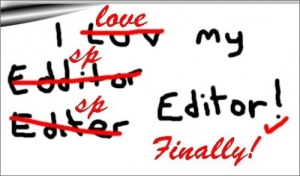Non-writers are always shocked when I tell them I’m doing edits yet again (as I am now for The Place I Belong). No, it’s not that I’m a particularly sloppy writer. It’s just the process that every book goes—or should go—through. The more eyes you can get on a manuscript, the more polished it will be when it’s published. Let me explain the stages of editing.
Step 1: Self-editing. This is what I do before I turn the book into my editor at Montlake Romance for the first time. It helps that I have a fabulous critique group where I get lots of constructive suggestions for improving the book. However, they only see about a third to half the book before I have to hand it in to the publisher (those nasty deadlines!). The rest is just little ole me reading my own work with as critical and detached an eye as I can bring to something I just sweated bullets over for the past nine months.
Step 2: Developmental editing (also known as line editing, confusingly enough). The developmental editor reads through the whole book with the big picture in mind. Are the characters’ emotional arcs consistent and satisfying? Are there any glaring plot holes? Are there any places where my writing is not up to snuff? Have I brought in the secondary characters in an effective way? She’s not worried about the proper use of commas and italics, although she often notices when I overuse a particular word (such as “locked” or “deep”, my two favorites in the current manuscript).
My D.E. and I will send the manuscript back and forth one or two times as we work through the issues she’s spotted. At this stage, I can still make major changes to the book if my developmental editor and I feel they are warranted. Then we return it—better and stronger!—to my supervising editor at Montlake so it can go to the copy editor.
Step 3: Copy editing. This is where the nit-picking begins (but doesn’t end). Commas, paragraphs, spelling of proper names, capitalization…all that gets scrutinized under a microscope. In addition, the copy editor checks that the characters’ eye color doesn’t change mid-book. Or that I don’t make some poor child go to school ten days in a row (yes, my copy editor caught that in Shower of Stars).
Timelines and continuity are checked carefully. Overuse of words and/or images is noted. Locations are vetted. If they’re real, is my description accurate? If they’re fictional, is my portrayal consistent throughout the book and the series? I can make significant changes at this stage, but I try not to since that would precipitate another round of copy editing.
I work through the annotated manuscript to fix all the problems the copy editor has marked. I confess to letting the experts handle the commas; whatever they say is right, I just agree to. I knew the punctuation rules once, but they’ve slipped my overstuffed mind by now. However, word choice is something I sweat over when it needs changing. I think that’s my training as a poet coming to the fore. When you can only use a few words on a page, they take on a huge importance.
There are times when I exercise my right as the author of the book to “stet” a suggested change. That means I want to keep it the way I wrote it. The folks at Montlake have a great deal of respect for their authors, so this is never a problem with them.
I return the polished-up manuscript to my supervising editor who forwards it to the formatter. This is where it gets turned into what you’d recognize as a book with page numbers and pretty chapter headings. In this form, the pages are called “galleys.”
Step 4: Proofreading. I get the galleys after the Montlake proofreader goes over them and marks his/her corrections. At this point, I am only allowed to correct actual mistakes that somehow snuck in during the formatting or weren’t caught in the copy editing stage. (It seems impossible but this does happen.) No major changes can be made because that would require reformatting the book. Again, I’m allowed to say no to changes the proofreader suggests because I’m the author. Love that!
Finally, I am done with the editing. Someone at Montlake does one more pass through the galleys after they receive my annotated version.
Do I get really tired of seeing that same book over and over again? Oh, yeah! However, this tedious process is what allows me to sleep at night, knowing my editors and I have done our level best to make the book as perfect as it can be.




Excellent post, thank you
Arran
Nap on desk well deserved! 🙂